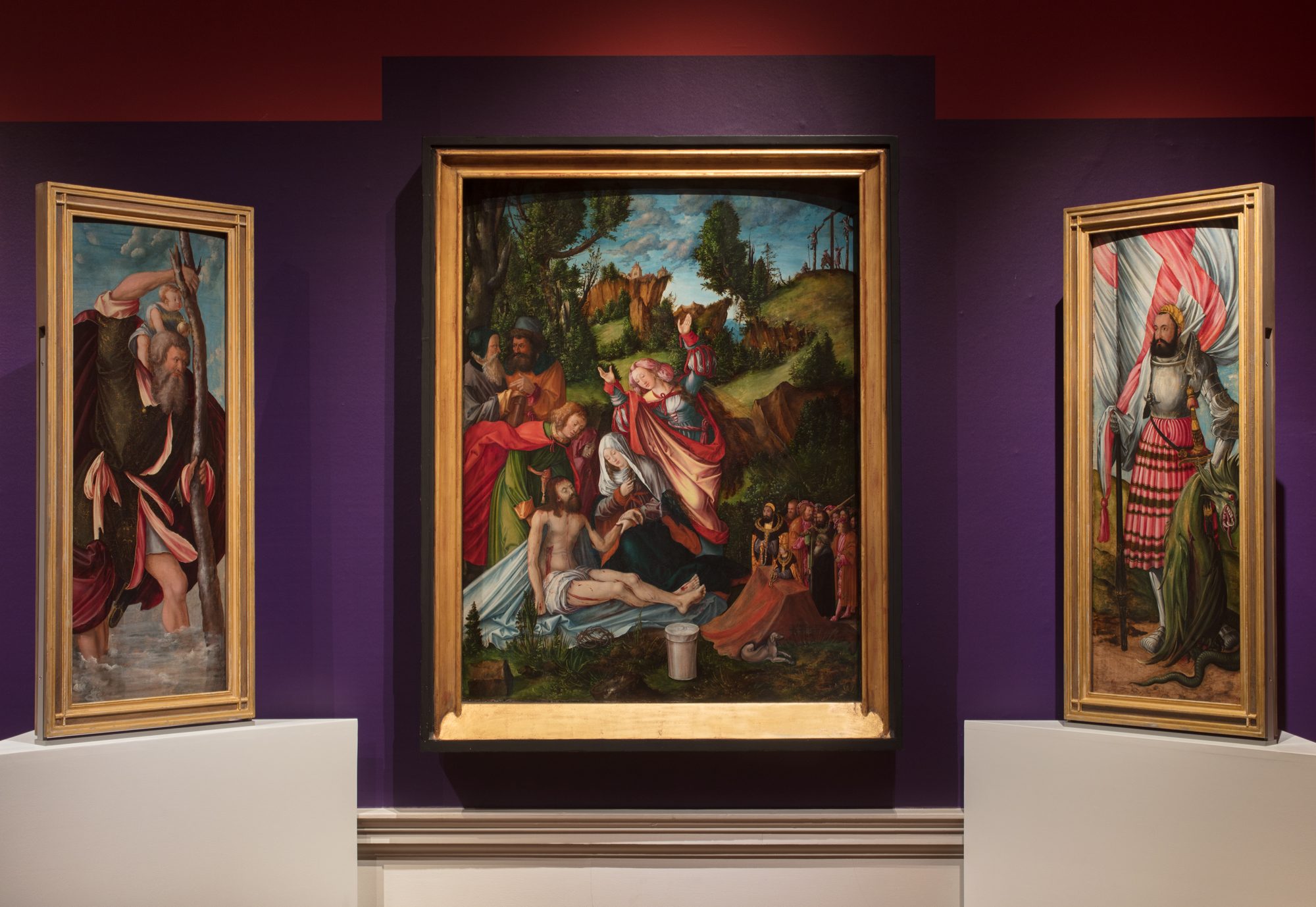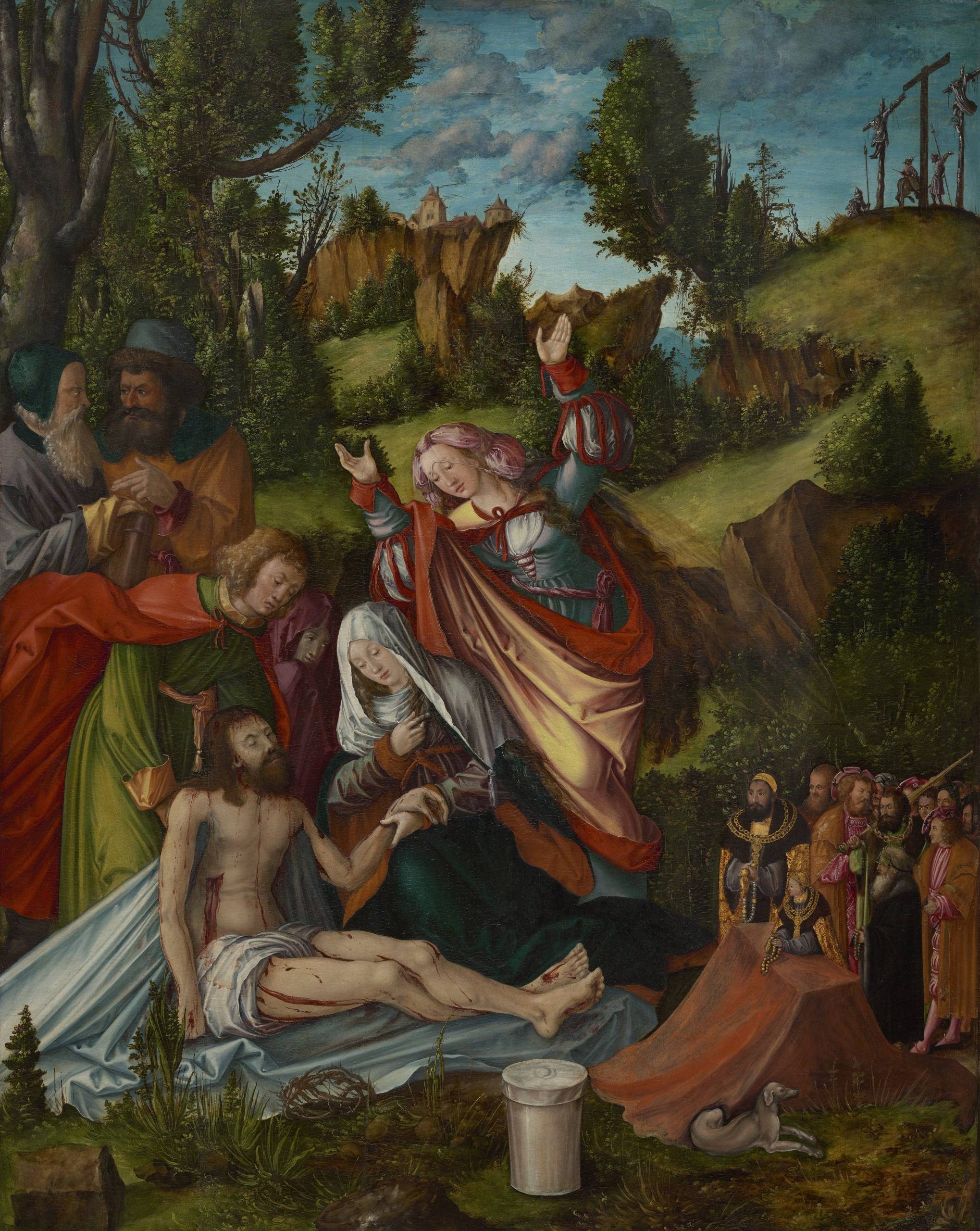Christine Cluley, one of Compton Verney’s tour guides, explains how her research led to a masterpiece being reunited to celebrate our 20th anniversary.

On Thursday 22 May 2008, two visitors to our Northern European gallery expressed great interest in the armour worn by St George, who is portrayed in one of the two altarpiece wings by an unknown Franconian master in Compton Verney’s collection. They suggested the armour was German landsknecht style – unaware of the term I investigated and discovered it was armour worn by German mercenary foot soldiers in the 16th century.
Intrigued, I delved into the Curatorial department’s files to learn more about these objects and was immediately captivated by the fact they were part of a “lost” masterpiece. I learned that the altarpiece wings were part of a triptych by an unknown artist, which included a central panel showing the Lamentation of Christ. The three panels that formed the triptych had been discovered in 1955 by architectural historian Nicholas Pevsner when surveying St. Martin’s church, Little Ness, Shropshire, who believed it was of “considerable interest and value” and “certainly ought to be better known”. They would have originally been attached to each other but had been separated at an unknown date, probably in the 19th-century.
Pevsner’s advice that the triptych should be transported to experts in London was ignored, until 1983 when Robin Bradbury arrived as the replacement vicar. He recognised them as being valuable and may have noted Pevsner’s recommendation. In 1993, with money needed for church repairs, this unknown masterpiece set off on another stage on its journey of discovery – to Sotheby’s auction house in London.
The triptych was examined by Sotheby’s and cleaned for the auction. A monogram belonging to the famous renaissance artist Albrecht Dürer, painted on the central panel, was discovered to be a later addition and was removed by conservators.
The main panel and wings were sold as separate lots because Sotheby’s could not be certain that they were connected. Both the central panel and side wings were sold twice before they were bought by the National Galleries of Scotland and Compton Verney respectively in 1998.
Prior to each sale, world-renowned art historians were invited to offer their opinions. No one thought the artist was Dürer, but they agreed it was by a master painter who was familiar with his style. There were some differences of opinion about the identity of the patrons, depicted in little on the central panel, but there was a consensus that the altarpiece was probably commissioned by the Knights of The Order of the Swan (a rich public charity) to commemorate the death of Kasimir, the Margrave of Brandenburg Kulmbach in 1528. The miniature patrons are wearing the regalia of this order.
I was fascinated by the mysteries which still surrounded the triptych and so began a series of trips across Europe to find out more about it. By this time my husband, Dick, had become my willing aide and so we set off to Shropshire and then to Germany, retracing the footsteps of the Lamentation Altarpiece.
In Germany, I enlisted the help of a friend, Margaret, who was fascinated by the story and fluent in German. She became my personal German researcher, tirelessly contacting relevant history books and sending on information. I travelled to Ansbach to investigate the chapel dedicated to St. George and the Knights of the Swan within the church of St. Gumbertus. Here we could see three stained glass panes in the window depicting Kasimir, his wife Susannah and his brother George the Pious. We visited Heilsbronn, the abbey dedicated to the Margraves, with many stunning tombs, more triptychs and portraits of Susanna, Kasimir and George. We had seen a lot but had not made any discoveries.
However, on 15th December 2009 we made a breakthrough! Dr. Tobias Capwell, an authority on armour at Wallace Collection identified the armour worn by St George as fighting and field armour for knights on horseback. This armour was also used in jousting and was designed for Maximillian I in c.1515. This suggested that the altar wing panel depicting St George depicted someone more important than a mere German foot soldier – perhaps Kasimir or his brother George?

The years 2010 from 2013 were very busy. As one of the mysteries around the Altarpiece was how it had ended up Little Ness, I went to Shropshire Archives, where I consulted letters to Francis Darby from James Inskipp and C. J. Nieuwenhaus. Darby’s family had donated the Altarpiece to the church in 1928 and Nieuwenhaus and Inskipp may have possibly brought the triptych to Britain from Germany. I also travelled to London, Dublin and Edinburgh to consult with scholars and experts on how to further uncover the provenance of the Altarpiece. However, hours spent in the archives of auction houses and galleries revealed no new leads.
In July 2011, Dr Miriam Kirch, an American scholar and lecturer at University of Alabama, contacted Dr Tico Seifert, Senior Curator of Northern European Art at the National Galleries of Scotland, who put her in touch with me. Her speciality is 16th-century German art and, particularly, princely patronage. Through her research on Susanna of Bavaria, wife of Kasimir, Dr. Kirch came across references to Susannah having commissioned a votive painting from Albrecht Dürer. This led her to learn about the Lamentation Altarpiece and she was intrigued by its potential connection to Sussanah. It is thanks to her scholarship that more of the history of the triptych was revealed. She discovered that the altarpiece had once been in the collection of Christian Friedrich von Knebel who made a record of it in a manuscript in 1768. Knebel stated that this painting was signed and dated 1518 and was, therefore, painted, in the year of Kasimir’s marriage with Susanna (1502–1543). Susanna was described by Knebel as ‘Dürer’s great protectress’, indicating Susanna’s involvement with art patronage at this time. Whilst this information allowed us to trace the painting further back in time, it also raised other questions – the central panel is not dated or signed, although the outer panels on the altar’s wings are dated. These depict St Catherine and St Barbara and are dated 1519. The plot thickened.
During the next seven years no new information was revealed, and other projects took over my life. However, in July 2019 we returned to Germany and called on Dr Andreas Curtius and his team in Nuremburg. They were fascinated by the story history, offered to check their files but could find nothing. We then visited Plassenburg Castle, Kulmbach, where we were welcomed by their archivists, who offered us coffee and biscuits whilst we sat on the ramparts of this stunning castle, once the home of Kasimir. They too were enthralled with the story but could not enlighten us further.
In 2021, wheels were put in motion to bring the wings and the central panel together in a display at Compton Verney, thanks to the efforts of Compton Verney’s curatorial team and Dr Tico Seifert. Further experts were consulted and more information agreed. It was thought likely that the depiction of St George was based on Kasimir whilst the depiction of St Christopher could depict his brother George. This has not been proved conclusively and recent examination of the depiction of Kasimir and George in the chapel of St Gumbertus raises further questions as in this instance it is George who is shown with the dragon not Kasimir.
Undoubtedly there are likenesses between the two male saints and the patrons depicted in the lower right-hand corner of the Lamentation Altarpiece, providing further evidence that the wings and central panel belonged together.
Whilst more information has been uncovered, this research project has shown how hard it can be to trace an artwork’s origins. The artist remains unidentified, the reason behind the commissioning of the painting has not been revealed, nor have we located the church where the triptych was to stand originally. Further research is also needed to discover how Christian von Knebel obtained the Triptych in 1768. We now know when the triptych arrived in England but not by whom it was conveyed.

I can offer my theories as to its purpose and how von Knebel may have obtained it, but much is still shrouded in mystery.
The religious criticisms raised by the monk Martin Luther in the early 16th century challenged the power and standing of the Catholic church. So great was the Church’s concern that a Diet (a forum for debate about religious and political matters) was arranged at Augsburg in 1518 for Cardinal Thomas Cajetan to question Luther. The Holy Roman Emperor, Maximilian I, used this occasion to arrange the marriage of his niece, Princess Susanna of Bavaria to Kasimir, Margrave of Brandenburg-Ansbach.
It is possible that Susanna, Kasimir and George attended the interrogation, and that Susanna, horrified by what she heard, commissioned the painting to emphasise her piety and support of the Catholic religion. In the painting, these concerns are depicted as terrible wounds on Christ’s body– the red paint standing out vividly. This much blood is not common in typical crucifixion paintings. The red blood is also emphasised in the bold red stripes in Mary Magdalen’s robes. Mary Magdalene, whose figure is much larger than usual, fills almost one third of the painting. The Magdalene’s pot of ointment is also very large and prominently displayed. Is she protecting Christ (and thus the church) from the onslaught of the new and destructive ideas formulated by Luther?
As to how the triptych made its way into Knebel’s possession, it may have been sold by the last Margrave of Brandenburg, Prince Christian Friedrich Carl Alexander in the mid-18th century. On inheriting his title, he found his lands to be in great debt and, determined to reduce it, built a ceramics factory in Ansbach, raised sheep on his estates, hired out his Landsknechts troops to George III, founded his own bank, and finally, having significantly reduced the debt, sold Brandenburg to Prussia. As a Protestant, he may not have valued a Catholic work of art like the Lamentation highly and sold the triptych to Christian von Knebel.
There is much still to discover, and my adventure is not yet over as I continue to try and trace the history of this artwork, which has captivated my interest for over 17 years!
I would like to thank all of those who have helped made my research and this display possible, particularly, Dr Miriam Kirch, Dr Tico Seifert, Prof. Noel Chaney, and Jane Simpkiss. I am grateful for their help and support throughout this journey.

